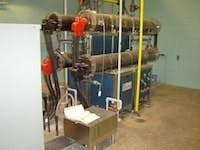Faced with increasing water consumption demands from its growing customer base, Forest Park Water needed to double the capacity of its existing facility.
So how did Forest Park Water address its capacity concerns, while setting record efficiency levels?
Project Background
The northern suburbs of Philadelphia include two counties—Montgomery and Bucks—which are not only among the state’s most populous but also among the fastest growing. Owned and operated by the North Penn and North Wales Water authorities, Bucks County-based Forest Park Water was faced with increasing water consumption demands from its growing 52,000-customer base. Forest Park Water needed to double the capacity of its existing facility.
For its chlorination needs, Forest Park chose an on-site sodium hypochlorite generating system, which has delivered record, never-before-validated efficiency levels.
“We chose to use the on-site sodium hypochlorite generation technology mainly for its safety and reliability,” said Wayne Letourneau, Forest Park Water’s facilities director. “The 0.8% on-site sodium hypochlorite solution is non-hazardous and stable. The only byproduct is hydrogen gas, which can be safely vented into the atmosphere.”
Forest Park’s engineering firm, Gannett Fleming of Harrisburg, Pa., designed the on-site sodium hypochlorite generation system and the water authorities awarded the general contract, which included two 1,200 lb per day ClorTec generating units, to Severn Trent Services Water Purification (now De Nora Water Technologies). The new Forest Park Water Treatment Plant operates at an average flow rate of 15 million gal per day (mgd), with seasonal fluctuations ranging to more than 23 mgd. The on-site hypochlorite generation system has produced more than 400,000 lb of chlorine since it was commissioned.
Sodium Hypochlorite Generating Technology
Three common consumables are used in the sodium hypochlorite generating process: salt, water and electricity. The system operates by feeding softened water into a brine dissolver. The salt dissolves to form a brine solution, which is further diluted to the desired salt solution. The salt solution is then passed through electrolytic cells, which apply a low-voltage DC current to the brine to produce the sodium hypochlorite. The solution is then safely stored in three 12,000-gal day tanks. When it reaches the low-level set point, the system automatically restarts to replenish its supply.
The 0.8% solution generated from the ClorTec system can also be directly used and fed to the membrane elements to act as a disinfectant during routine maintenance and cleaning procedures for the membrane filtration system.
The ClorTec unit’s clear cylindrical cell allows full visibility and easy access to the electrode array. Cells can be removed as a single unit, eliminating the time and labor spent disassembling cell structures and handling electrodes individually.
Full-Scale Operation
In order to maximize ratepayer dollars, Forest Park Water and Gannett Fleming used a “guaranteed whole life” approach to the procurement process, allowing each supplier to submit a bid with guaranteed efficiencies backed by a performance bond. Typically, an on-site sodium hypochlorite generating system consumes 2.5 kWh per lb of chlorine and 3.5 lb of salt per lb of chlorine. De Nora Water Technologies has significantly advanced on-site hypochlorite generation technology through an enhanced proprietary electrode coating, which significantly reduces the consumption of salt and electricity, providing greater operational efficiency.
De Nora Water Technologies met its operational efficiency guarantee at the Forest Park facility by:
• Reducing salt consumption from 3.5 to 2.34 lb per lb of chlorine, representing a cost reduction of more than 25% in salt consumption; and
• Reducing energy consumption from 2.5 kWh to 1.94 kWh per lb of chlorine—a cost reduction of more than 20% in power.
Not only has the ClorTec system surpassed the performance requirements of the contract, Letourneau expresses satisfaction with the system’s design and operation.
“The ClorTec computer program makes our job easier by identifying and pinpointing the source of any operational problems. That minimizes the time we have to spend trouble shooting system problems," Letourneau said. "The lack of ongoing maintenance issues with the system has been a pleasant surprise, too. And the installation of the ClorTec system, the training and the service made the change from gas to liquid seamless.”



